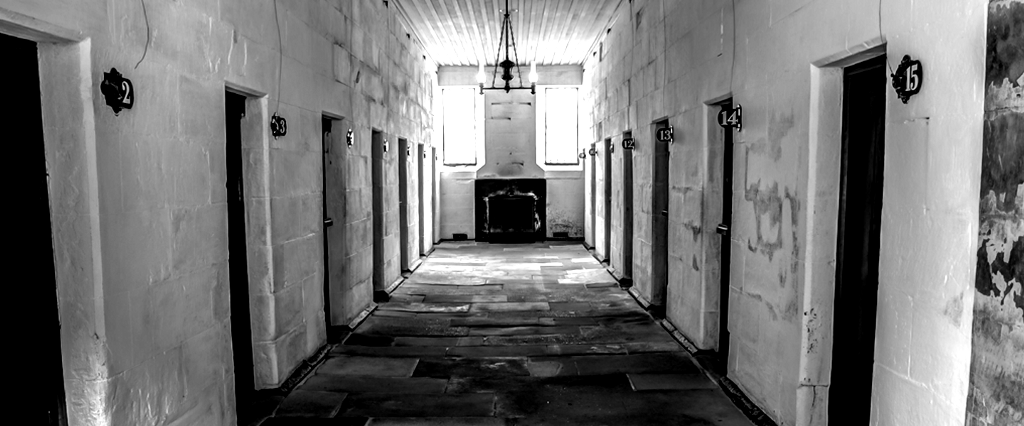Suk-won Kang was worn out from working 80 hours a week at a Hyundai plant in Korea so he surrendered his phone, swapped his suit for a regulation uniform and slept on the floor of a 50 foot cell for a week.
That’s right: he went to “prison” to unplug.
“I feel more refreshed here and my mind is light,” he told the CBC following his release last month.
“Here” is Prison Inside Me, a penal-themed stress-reduction center 50 miles northeast of Seoul, where meals are served through a slot in the door and a two-night stay costs 150,000 won ($146.) As explained in the “introduction to the program” on the Prison Inside Me website:
Desires, habits, duties, money…
Even if you are not trapped, you
are not free in prison!
It is not my outside prison that keeps me, but
my beliefs, obsessions, habits.
I am free in the caged space that is out of my prison!
Twenty eight identical cells feature a toilet, a tea set and a yoga mat on heated wooden floors. It’s essentially voluntary solitary confinement in a faux prison, complete with a panic button should you wish to tap out. (While the doors are locked from the outside, inmates are shown how to undo the latch from within.)
Jennifer Jung Kim, a professor of Korean history and culture at UCLA, explains this is just a contemporary twist on the traditional Buddhist retreat. “Koreans have always tried to escape by visiting temples, where neither screen time nor speaking is permitted.” Prison Inside Me had to make a huge concession last year — permitting inmates to check their smartphones at least once a day. Otherwise, staff said, they obsessed about potential emergencies and could not relax. (Emergencies were in fact very seldom, the staff noted.)
Matt Friedman, CEO of the Mekong Group, a nonprofit working to end modern slavery in Asia says the fast-pace lifestyle and work ethic in South Korea makes it hard to find any peace or serenity. “These voluntary prisons offer the complete opposite experience — a place completely devoid of all stimulus and activity where people can refuel away from friends and family without being perceived as being weak or not up-to-the-mark.”
There are, of course, similar programs stateside. For example, after spending a decade and a half obsessively publishing blog posts multiple times a day, seven days a week, my friend Andrew Sullivan attempted to fix his “distraction sickness” by spending ten days at a silent meditation center, where no one spoke or looked each other in the eye — what Buddhists refer to as “noble silence.” Andrew dismisses the notion outright when I suggest he might find benefit at Prison Inside Me. “Solitary confinement without meditation is self torture,” he explains. “It’s just another form of not living.”
Ironically, it was the Quakers who first conceived of solitary confinement in the mid 1800s as a more humane solution to overcrowding. Instead, it drove many men mad. Likewise, after Germany adopted the Quaker solitary confinement model in 1890, the High Court condemned the practice, noting “a considerable number of prisoners fell into a semi-fatuous condition…and others became violently insane.”
Kang disagrees with this finding. “This is freedom,” he explained to the CBC. “ I’ve been overworking, which is the main reason I’m here.” This sentiment reflects the irony of the jail-themed retreat, explains the facility’s co-founder, Ji-hyang Noh. “Solitary confinement is not considered prison — the true prison is the world outside.” Noh’s husband, Yong-Seok Kwon, conceived of “Prison Inside Me” after working 100-hour weeks as a prosecutor for years. “I thought I would feel better if I stayed in solitary confinement,” he said. “At least there are no people, no phone calls looking for me, no smoking, no drinking.”
But is it ethical? As Mother Jones noted in a 2009 report on solitary confinement, almost all maximum-security prisoners in America are kept in some form of singular detention for large portions of their sentences; the lack of regular human contact is considered inhumane by many rights advocates who have taken to courts to challenge its constitutionality. I reached out to one such group — Solitary Watch, a nonprofit that investigates solitary confinement in U.S. prisons — to get their take on therapeutic incarceration. Safe to say they were nonplussed: “Comparing what goes on in these theme resorts to actual solitary confinement is ridiculous — and even offensive, given that solitary is now widely considered to be torture,” they replied via email. Stuart Grassian, an expert in solitary confinement, agrees. “I think it is wrong, and dangerous, to call this ‘solitary confinement.’ The fact people can leave if they need to means there is none of the fear and power imbalance associated with solitary confinement in prisons.”
Overworking has killed so many people in South Korea that they gave it a name: Gwarosa. (In Japan, “death from overwork” it’s called karoshi; in China, guolaosi.) With its people logging more than 2,000 hours a year, after Mexico, South Korea overworks the second-most of the 35-nation Organization for Economic Co-operation and Development, where the average is 1,764 hours a year. The notion of therapeutic lock up isn’t new to the Korean peninsula: Former South Korean President Kim Dae-jung, complaining that he lacked time to read books because of his busy schedule once famously said, “I wish I could go back to prison.”
But it all comes down the the perceived intent of the isolation, Grassian explains, which plays a critical role in how it’s experienced. For example, I’m familiar with surrendering a significant chunk of my paycheck to sit in a sensory deprivation tank, which market themselves as psychedelic experiences of dissociation and hallucination. I found it to be exceedingly pleasurable, comparable to heroin, even. But when done against a person’s will, Grassian says, the “therapy” can break bad:
“The CIA tried this years ago — until folks committed suicide.”

